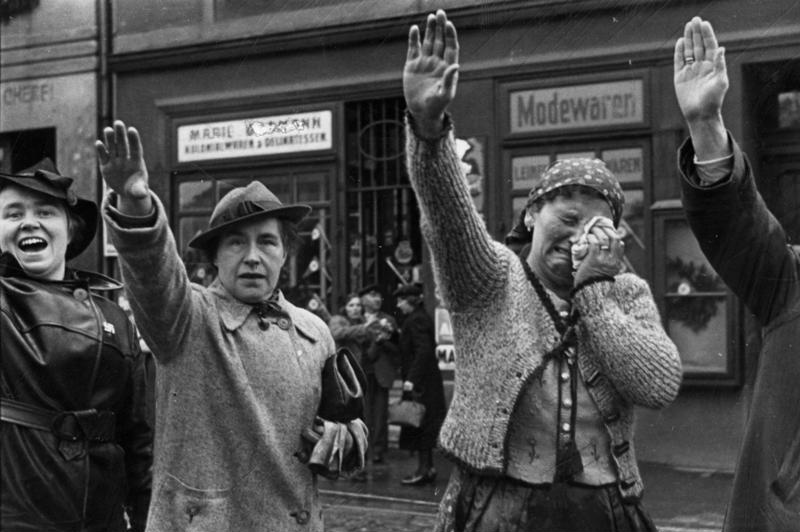World War I was called “the War to End All Wars” because the human death toll had never been as extreme. Approximately 17 million people died between 1914 and 1918, while 20 million more people were injured. WWI was the result of a cataclysmic collision between empires, new technology, colonialism and nationalism. In the face of such calamity, few believed that the world would go to war again – let alone just twenty years later. But that’s exactly what happened World War II’s death toll was exponentially worse, with as many as 85 million people dying around the world.
World War II lasted from 1939 and 1945. The number of injured and dead was due to many factors, such as deadlier military technology, genocide, epidemics, famines and the atomic bomb. To those who did not live through WWII, the scale of the war is impossible to grasp.

Statistics are one way to understand the impact of WWII, but images and stories bring the war home in a more intimate way. These WWII photographs do just that.
Omaha Beach

On June 6, 1944, Allied forces invaded France. These soldiers are Americans who were injured on Omaha Beach. Omaha Beach is a landing area in Normandy, northern France, that was the responsibility of American troops. The goal was for the Americans to land at Omaha and link with the British landings at Gold Beach, as well as the American landings at Utah Beach. The U.S. troops were supported by the Free French, Canadian and British navies. The massive buildup of Omaha beach has had a lasting impact on the area. Shrapnel and glass and iron beads from munitions explosions are still found on the beach. Experts estimate that there will be debris from WWII for one or two hundred years.
USS Shaw

American sailors stand on the base at Pearl Harbor, watching Japanese planes explode the USS Shaw during the Japanese attacks on Pearl Harbor on December 7, 1941. The Shaw’s destruction was one of the most iconic images of WWII. Despite receiving major damage in the attack, the ship was repaired and back in action within months. The Shaw served in the Pacific until the end of WWII.
The Jaws of Death

A U.S. landing craft is approaching Omaha Beach during the D-Day invasion. This invasion of Normandy was necessary to liberate continental Europe. The Americans, British, French, Canadians, Polish, Belgians, Czechs, Greeks and Dutch came ashore, where they found staggering amounts of weaponry from Nazi Germany. The Germans had dug bunkers, laid mines, installed barbed wire and included a force of thousands of soldiers. Allied casualties were over 10,000, with 2,500 killed. Despite the odds, the sacrifice at Omaha Beach enabled 155,000 Allied troops to come ashore.
Iwo Jima

This is one of the most famous photographs of all time. It shows five American Marines and one sailor raising the American flag over Mount Suribachi during the Battle of Iwo Jima. Mt. Suribachi is a 169 mile high mountain on Iwo Jima. The Japanese built tunnels and bunker systems in the mountain. On February 23, 1945, Allied forces invaded the island, since it was a key strategic point in the Pacific theater of war. The Americans prevailed, in a battle that killed 20,000 Japanese and 7,000 Americans.
German Civilians Face the Holocaust

As the concentration camps were liberated, Allied forces brought German civilians to witness the sites of the atrocities against Jews and other groups. In this image, a German girl’s overwhelmed with emotion as she walks past the bodies of 800 victims murdered by SS guards. As the Allies closed in on the camps, the Nazis tried to flee with their prisoners. In Nammering Germany, the Germans stopped and dumped 800 people who had died during the evacuation into a mass grave. On May 17, 1945, American soldiers brought villagers to the site and forced them to bury each person in individual graves.
Sudeten Woman

This controversial photo shows a woman from the land that is now the Czech Republic saluting the conquering Germans and crying. Some people believe she was crying in despair because of the Nazi invasion of the Sudeten. Others think she was crying out of joy for their arrival. Either could be true. There were many Germans who lived in Egerland, in the Czech Republic. Hitler encouraged the Germans to agitate for self-determination, which he then used as an excuse to invade. After the war, the area returned to Czech control and 90,000 Germans were expelled from the town.
The Blitz

Firefighters quickly put out a fire caused by the German Blitzkrieg in London, 1941. The Germans carried out nightly attacks over the U.K. in a battle for supremacy for the air. Raids on London happened 56 out of 57 nights from September 7, 1940. Finally, in 1941, the British prevailed.
Antwerp

After Normandy, the Allies had to move supply lines deeper into Europe. They created extensive and complex supply lines, which required the use of the port at Antwerp, which allowed the Allies to get closer to the German border. But the Nazis wouldn’t let the Allied forces advance without a fight. They initiated massive V2 bombings. On November 27, when this photo was snapped, a V2 hit a crucial supply line, killing 157 people. These bystanders are staring at one of the victims of the attack. Eventually, this situation led to the Battle of the Bulge.
Hellcat Crash

A Grumman F6F Hellcat (VF-2) plane crashes onto the deck of the USS Enterprise. Lt. Walter L. Chewning, Jr. is seen here climbing up the side of the plane to help the pilot, Byron Johnson, who escaped. The Enterprise was on its way toward the Makin Atoll in the South Pacific. The Japanese and Allies fought for the atoll during four days starting on November 20, 1943.
The Kiss

A sailor kissing a nurse during the V-J Day celebrations in Time Square, New York City, on August 14, 1945. This photo, which was taken by Alfred Eisenstaedt, may be the most famous of the War’s end. However, there are dozens of other photographs showing celebratory kisses as America let loose.
Leipzig-Thekla

A young man sits on a stool next to a burned body inside the Leipzig-Thekla concentration camp. During the battle for Leipzig, the 69th Infantry Division discovered Leipzig-Thekla, a subcamp of the Buchenwald concentration camp. On April 19, 1945, just one day before the Allies arrived, the SS guards set fire to the barracks in order to kill as many victims as possible so they could not escape.
Operation Overlord

U.S. General Dwight D. Eisenhower is shown giving instructions to paratroopers in England in preparation for the D-Day invasion on June 6, 1944. Eisenhower was Supreme Commander of Allied Expeditionary Forces and he planned the invasion of Europe, which he called Operation Overlord. On this day, he delivered a speech to every Allied soldier, either by radio or on paper, reminding them that the eyes of the world were upon them and exhorting them to victory. Eisenhower also wrote a statement accepting all blame if the Operation didn’t work; however, he never spoke the words. The note remained in his pocket.
Māori Battalion

Here Māori soldiers from New Zealand are performing their traditional war cry, known as a haka, in Helwan, Egypt, June 1941. The Māoris of C Company, 28th Māori Battalion of the 2nd New Zealand Division were known for their fierce battle skills. They earned a formidable reputation during Allied campaigns in Italy, Greece and North Africa. After confrontations with the Māori, Erwin Rommel said “Give me the Maori Battalion and I will conquer the world.”
Warsaw Ghetto

A horrified young boy raises his arms as German soldiers capture Polish Jews during the Warsaw ghetto uprising sometime between April 19 and May 16, 1943. Despite many attempts, no one has conclusively identified the young Jewish boy. However, in the book “The Boy: A Holocaust Story” (Farrar, Straus & Giroux), author Dan Porat tries to find the boy and tells the story of the community of Jews who were seized after the Warsaw ghetto uprising.
Majdanek

On July 24, 1944, Soviet forces liberated the Majdanek concentration camp in Lublin, Poland. As seen here, bones of the victims littered the area. The camp was captured nearly intact because the Soviets advanced so quickly the Germans did not have time to destroy the evidence of war crimes. The camp initially was used for slave labor, but it was converted to an extermination facility when the Germans initiated Operation Reinhard, their plan to kill every Jew in Poland.
Two Survivors

Two women who survived a bombing by the Germans stand amid the ruins of the almshouse where they lived. A German bombing raid destroyed it in Newbury, England on February 10, 1943. This bomb killed 15 people and injured 41 more.






